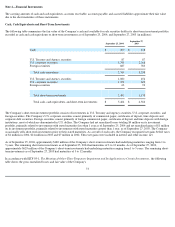Apple 2004 Annual Report Download - page 79
Download and view the complete annual report
Please find page 79 of the 2004 Apple annual report below. You can navigate through the pages in the report by either clicking on the pages listed below, or by using the keyword search tool below to find specific information within the annual report.
Vendor Non-Trade Receivables
The Company has non-trade receivables from certain of its manufacturing vendors resulting from the sale of raw material components to these
manufacturing vendors who manufacture sub-assemblies or assemble final products for the Company. The Company purchases these raw
material components directly from suppliers. These non-trade receivables, which are included in the consolidated balance sheets in other current
assets, totaled $276 million and $184 million as of September 25, 2004 and September 27, 2003, respectively. The Company does not recognize
any profits on these sales or reflect the sale of these components in its net sales.
Inventory Prepayment
In April 2002, the Company made a $100 million prepayment to an Asian supplier for the purchase of components over the following nine
months. In return for this deposit, the supplier agreed to supply the Company with a specified level of components during the three consecutive
fiscal quarters ended December 28, 2002. During the first six months of 2003, the remaining $53 million of the deposit balance was fully utilized
for the purchase of components. The deposit was unsecured and had no stated interest component. The Company imputed an amount to cost of
sales and interest income during each period the deposit was outstanding at a 3.25% interest rate to reflect the economics of this transaction.
Derivative Financial Instruments
The Company uses derivatives to partially offset its business exposure to foreign exchange and interest rate risk. Foreign currency forward and
option contracts are used to offset the foreign exchange risk on certain existing assets and liabilities and to hedge the foreign exchange risk on
expected future cash flows on certain forecasted revenue and cost of sales. From time to time, the Company enters into interest rate derivative
agreements to modify the interest rate profile of certain investments and debt. The Company's accounting policies for these instruments are based
on whether the instruments are designated as hedge or non-hedge instruments. The Company records all derivatives on the balance sheet at fair
value.
The following table shows the notional principal, net fair value, and credit risk amounts of the Company's foreign currency instruments as of
September 25, 2004 and September 27, 2003 (in millions):
The notional principal amounts for derivative instruments provide one measure of the transaction volume outstanding as of year-end, and do not
represent the amount of the Company's exposure to credit or market loss. The credit risk amount shown in the table above represents the
Company's gross exposure to
75
September 25, 2004
September 27, 2003
Notional
Principal
Fair
Value
Credit Risk
Amounts
Notional
Principal
Fair
Value
Credit Risk
Amounts
Foreign exchange instruments qualifying as accounting
hedges:
Spot/Forward contracts
$
598
$
(3
)
$
3
$
464
$
(21
)
$
—
Purchased options
$
482
$
4
$
4
$
512
$
3
$
3
Sold options
$
521
$
(3
)
$
—
$
645
$
(8
)
$
—
Foreign exchange instruments other than accounting
hedges:
Spot/Forward contracts
$
609
$
3
$
4
$
445
$
3
$
3
Purchased options
$
—
$
—
$
—
$
8
$
—
$
—
Sold options
$
—
$
—
$
—
$
5
$
—
$
—
























